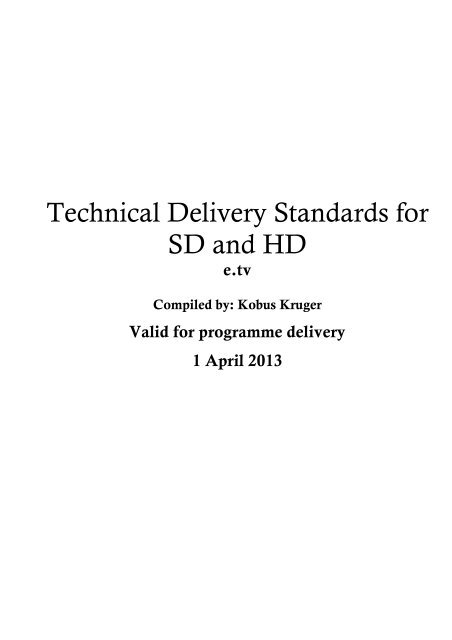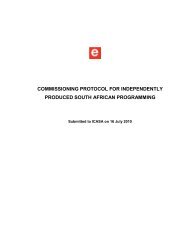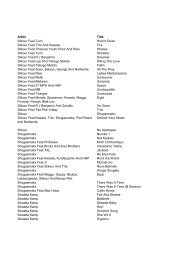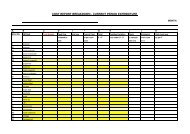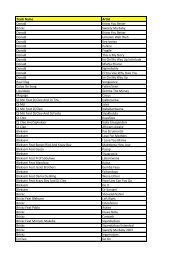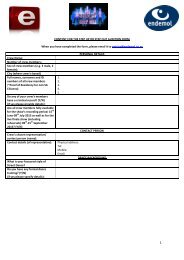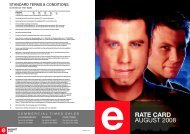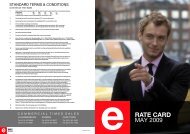Technical Delivery Standards for SD and HD - e.tv
Technical Delivery Standards for SD and HD - e.tv
Technical Delivery Standards for SD and HD - e.tv
You also want an ePaper? Increase the reach of your titles
YUMPU automatically turns print PDFs into web optimized ePapers that Google loves.
<strong>Technical</strong> <strong>Delivery</strong> <strong>St<strong>and</strong>ards</strong> <strong>for</strong><br />
<strong>SD</strong> <strong>and</strong> <strong>HD</strong><br />
e.<strong>tv</strong><br />
Compiled by: Kobus Kruger<br />
Valid <strong>for</strong> programme delivery<br />
1 April 2013
1. SCOPE OF DOCUMENT 4<br />
2. INTRODUCTION 5<br />
3. TECHNICAL RESPONSIBILITIES FOR PROGRAMMES 6<br />
3.1 General Responsibilities<br />
3.2 <strong>Technical</strong> Liaison<br />
3.3 Relaxation of <strong>St<strong>and</strong>ards</strong><br />
4. GENERAL TECHNICAL REQUIREMENTS 7<br />
4.1 Origination Material<br />
4.2 Video General <strong>Technical</strong> <strong>St<strong>and</strong>ards</strong> 7<br />
4.2.1 Video St<strong>and</strong>ard<br />
4.2.2 Video levels <strong>and</strong> Gamut<br />
4.2.3 Aspect Ratio<br />
4.2.4 Safe Area <strong>for</strong> action <strong>and</strong> Captions<br />
4.2.5 Time Code<br />
4.2.6 On Air “Bugs”<br />
4.3 Audio General Requirements 8<br />
4.3.1 Audio <strong>St<strong>and</strong>ards</strong><br />
4.3.2 Audio Level, Reference level <strong>and</strong> Measurement<br />
4.3.3 Line Up Tones<br />
4.3.4 Stereo Balance <strong>and</strong> Phase<br />
4.3.5 Lip-Synchronisation<br />
5. GENERAL QUALITY REQUIREMENTS 9<br />
5.1 <strong>Technical</strong> Quality Grading<br />
5.2 General Vision Quality Requirements<br />
6. SPECIFIC REQUIREMENTS FOR <strong>SD</strong> TAPE DELIVERY 11<br />
6.1 Specific <strong>Technical</strong> Requirements <strong>for</strong> tape delivery<br />
6.1.1 <strong>Technical</strong> acceptance procedures<br />
6.1.2 Video Tape Format<br />
6.1.3 Audio track allocations<br />
6.1.4 Time-code <strong>and</strong> control track<br />
6.2 Specific Operational Requirements <strong>for</strong> tape delivery 12<br />
6.2.1 Line-up test signals clock <strong>and</strong> leader<br />
6.2.2 Recording Spanning more than one tape<br />
6.2.3 Recording reports 13<br />
6.2.4 TX Tape <strong>Delivery</strong><br />
6.2.5 Final Control Sheet<br />
6.2.6 Time Framne <strong>for</strong> delivery<br />
7. PROMO TAPE DELIVERY 14<br />
8. FILE BASE DELIVERY 15<br />
2
DELIVERY FOR <strong>HD</strong> MATERIAL<br />
9. <strong>HD</strong> DELIVERY FORMAT 16<br />
10. ACTION AND CAPTION SAFE AREAS 17<br />
11. AUDIO 17<br />
11.1 Stereo <strong>Delivery</strong><br />
12. EXAMPLES OF COMMON REJECTION POINTS 18<br />
13. ACKNOWLEDGMENT 18<br />
3
1. Scope of Document<br />
These technical specifications outline the delivery requirements <strong>for</strong> e.<strong>tv</strong><br />
While this document deals primarily with material <strong>for</strong> transmission, there are other<br />
factors to take into account such as re-versioning, these will be also be dealt with in this<br />
document.<br />
This document must also be used as a guide <strong>for</strong> operational staff within e.<strong>tv</strong><br />
Advances in production techniques <strong>and</strong> changes in operational requirements will<br />
necessitate review of this content from time to time.<br />
4
2. Introduction<br />
The purpose of this document, <strong>and</strong> associated material is to set out the technical<br />
requirements to ensure that material delivered is of a satisfactory st<strong>and</strong>ard, it is part of<br />
our role to advise on the avoidance of production equipment or techniques that we know<br />
to be technically inferior or contentious <strong>and</strong> we then need to find a practical way <strong>for</strong>ward<br />
that is acceptable to all parties.<br />
Prior to acceptance all programme material will be technically assessed to ensure that it<br />
meets e.<strong>tv</strong> delivery requirements <strong>and</strong> it will be graded using a ITU-R five point quality<br />
scale.<br />
If defects are discovered the tape will either be returned to the supplying company <strong>for</strong><br />
repairs or the rectification will be carried out by e.<strong>tv</strong> <strong>and</strong> the cost recovered from the<br />
supplier.<br />
Special circumstances may arise where material of a lower ITU grading may be accepted<br />
due to historical or artistic merit or where special production requirements apply. In<br />
these cases prior approval must be sought from the Transfers department who in turn will<br />
seek exemption if appropriate. Below factors will be taken into consideration.<br />
QC Review will always look at the below criteria:<br />
<strong>Technical</strong> Requirements:<br />
These sections describe the technical st<strong>and</strong>ards required to deliver material to e.<strong>tv</strong>, these<br />
are broadly Pass / Fail objective measurements.<br />
Quality Requirements:<br />
Quality Requirements deal with broadly subjective quality issues with picture <strong>and</strong> sound.<br />
Careless shooting, inappropriate production methods <strong>and</strong> faulty or subst<strong>and</strong>ard<br />
equipment can cause avoidable impairment to sound or vision. The 5 point grading<br />
system will be used.<br />
Operational Requirements:<br />
All material delivered must be to the correct st<strong>and</strong>ard, be accompanied by the correct line<br />
up sequences <strong>and</strong> accompanied with the correct in<strong>for</strong>mation <strong>for</strong> the “ingest” or tape<br />
delivery process.<br />
Remember that the technical assessment does not affect the quality grades given.<br />
Material could have passed QC grades but still be rejected due to technical issues.<br />
5
3. <strong>Technical</strong> Responsibilities <strong>for</strong> Programmes<br />
3.1 General Responsibilities<br />
Transfers Department is required to ensure that broadcast technical quality is<br />
maintained to a satisfactory st<strong>and</strong>ard <strong>for</strong> both <strong>SD</strong> <strong>and</strong> <strong>HD</strong> programmes<br />
This document is the responsibility of the Transfers Manager, tel +27 21 481 4724<br />
kobusk@e<strong>tv</strong>.co.za<br />
3.2 <strong>Technical</strong> Liaison<br />
For all <strong>Technical</strong> Liaison contact the Transfers Department to assist you in all matters –<br />
(including non tx reports) they will also be able to re-direct you if need be.<br />
3.3 Relaxation of <strong>St<strong>and</strong>ards</strong><br />
All programmes are expected to meet our required technical st<strong>and</strong>ards. The recognised<br />
exemption categories are tightly constrained <strong>and</strong> will not be invoked <strong>for</strong> the general<br />
convenience of programme makers. Where programmes fail to meet full broadcast<br />
technical specifications <strong>and</strong> fall outside these categories it will be necessary to apply <strong>for</strong><br />
special exemption. Any proposal to deliver programme material which does not con<strong>for</strong>m<br />
to the technical st<strong>and</strong>ards in these guidelines must be agreed be<strong>for</strong>eh<strong>and</strong> with the Station<br />
Manager at e.<strong>tv</strong>. Copies of any written agreements must then be supplied with the<br />
transmission tape to assist the QC Person. This will allow discussions to proceed at an<br />
early stage <strong>and</strong>, although in no way guaranteed, it will reduce the likelihood of<br />
subsequent difficulties.<br />
3.3.1 There are five recognised categories <strong>for</strong> technical exemption.<br />
Artistic interest: Innovative or experimental productions which are made, of necessity, by<br />
those who do not have access to equipment or facilities meeting broadcast quality<br />
st<strong>and</strong>ards.<br />
Historic interest: News or programmes of a documentary nature which show historic<br />
events taking place or whose subject matter requires the use of archive material.<br />
Actuality material: News, features or documentaries of an actuality nature where better<br />
quality has not been possible because of limitations placed on the <strong>for</strong>mat or physical size<br />
of equipment used. Such limitations are those incurred as a result of shooting in difficult<br />
areas such as war zones, isolated locations, confined spaces or other difficult<br />
environments.<br />
Early television <strong>and</strong> cinema: Excerpts from historical archives where low technical quality<br />
was due to the then current per<strong>for</strong>mance of equipment used in its creation or where<br />
quality is now lower than at the time of original showing because of film or video ageing.<br />
Domestic equipment: Programmes which employ excerpts made using domestic<br />
equipment in which the context requires that it is used.<br />
NOTE: This is not permissible in <strong>HD</strong> masters<br />
6
4. General <strong>Technical</strong> Requirements<br />
<strong>Technical</strong> requirements must be met so that programme material is in the required<br />
<strong>for</strong>mat, which can be used reliably without any user intervention <strong>and</strong> can be passed<br />
through systems without noticeable impairment to the viewer.<br />
4.1 Origination Material<br />
• All origination <strong>SD</strong> material must be shot on 2/3” 3x CCD Cameras, 625 16:9<br />
FHA Aspect ratio<br />
• e.<strong>tv</strong> accepts, only by prior permission, material originated on cameras with CCD<br />
smaller than 2/3” or single chip cameras. Also, how the material is used in the<br />
program, must be cleared by e.<strong>tv</strong>. This material will be limited in duration<br />
depending on the nature of material.<br />
• <strong>SD</strong> Material originated using <strong>HD</strong> Cameras ex. XD Cam <strong>HD</strong> Cam, <strong>HD</strong> CamSR,<br />
DVCPRO <strong>HD</strong> or AVCIntra on 2/3” or 1/2 “ 3x CCD cameras is acceptable <strong>for</strong><br />
e.<strong>tv</strong>’s <strong>SD</strong> transmission. This material must be converted to 625 16:9 FHA Aspect<br />
ratio <strong>for</strong> delivery, using broadcast acceptable down conversion methods..<br />
• All other systems require prior approval from e.<strong>tv</strong>. Eg Mini DV, <strong>HD</strong>V, AVC<strong>HD</strong><br />
cameras.<br />
4.2 Video General <strong>Technical</strong> Requirements<br />
Material must comply with general ITU spec to ensure that Broadcast Quality material<br />
are received.<br />
4.2.1 Video St<strong>and</strong>ard<br />
All signals <strong>and</strong> recordings supplied shall be of the 625/50 interlaced 16:9 FHA st<strong>and</strong>ard.<br />
(see also 6.1.2)<br />
4.2.2 Video Levels <strong>and</strong> Gamut (illegal signals)<br />
We require that signals meet the easier EBU Recommendation R103-2000: Luminance<br />
limits -1% <strong>and</strong> 103% Chrominance 105% max - RGB values to not exceed limits -5% to<br />
+105.<br />
4.2.3 Aspect Ratio<br />
Programmes will be <strong>for</strong> 16:9 FHA St<strong>and</strong>ard presentation.<br />
4.2.4 Safe Areas <strong>for</strong> Action <strong>and</strong> Captions<br />
All programmes should be 16:9 FHA, titles must always be 4x3 title safe <strong>and</strong> shoot to<br />
protect 4x3<br />
4.2.5 Time-code<br />
Vertical interval time-code (VITC) is m<strong>and</strong>atory<br />
7
4.2.6 On air Bugs<br />
All programs must be bug (Graphics) safe. e.<strong>tv</strong> has two bugs on screen – jpeg available<br />
on request <strong>and</strong> can be emailed<br />
• The e logo top left of screen.<br />
• The age restrictions bug top right of screen.<br />
• During the end credits we put up a next up strap<br />
4.3 Audio General <strong>Technical</strong> Requirements<br />
4.3.1 Audio <strong>St<strong>and</strong>ards</strong><br />
Programmes shall be delivered in Stereo Format as required. The use of pre-emphasis<br />
<strong>and</strong>/or noise-reduction schemes during acquisition <strong>and</strong> post production is acceptable.<br />
However, the programme <strong>for</strong> final delivery should have no pre-emphasis or noise<br />
reduction scheme applied unless specifically required.<br />
Ch 1 Stereo. Mix L Channel<br />
Ch 2 Stereo Mix R Channel.<br />
Ch 3 M/E For international Acquisition<br />
Ch 4 M/E For international Acquisition<br />
M/E Track will only be required when delivering <strong>for</strong> international delivery.<br />
Mono shall be in Dual Mono <strong>for</strong>mat with identical <strong>and</strong> coherent audio on both Left <strong>and</strong><br />
Right channels. This is so that it may be used amongst stereo programmes.<br />
4.3.2 Audio Level, Reference Level <strong>and</strong> Measurement<br />
Programme audio levels shall always be measured by digital meters The Maximum or<br />
Peak Programme Level shall be measured with Digital meter <strong>and</strong> shall never exceed -6<br />
dB. Digital Audio Reference level is defined as -18dBfs<br />
4.3.3 Line-up Tones<br />
For Stereo sources, Stereo Line-up Tone shall be provided at a frequency of 1kHz +/-<br />
100Hz <strong>and</strong> shall indicate the Left <strong>and</strong> Right programme legs. All tones must be<br />
sinusoidal, free of distortion <strong>and</strong> shall be phase coherent between channels. Optionally,<br />
Step Tone sequences may be provided but if so then all tones must have been sourced at<br />
the same level <strong>and</strong> be phase coherent on Stereo feeds / tracks.<br />
4.3.4 Stereo Balance <strong>and</strong> Phase<br />
The two stereo legs, when sending identical programme (Mono), shall match within<br />
0.5dB <strong>and</strong> be phase coherent to less than 15 degrees at 10kHz<br />
4.3.5 Sound to Vision Synchronisation (Lip-synchronisation)<br />
The relative timing of sound to vision should not exhibit any perceptible error. Sound<br />
should not lead or lag the vision by more than 10ms.<br />
8
5. General Quality Requirements<br />
5.1 <strong>Technical</strong> Quality Grading<br />
Subjective quality of pictures <strong>and</strong> sound is difficult to assess. The ITU / CCIR 5 point<br />
scale <strong>for</strong> impairment is given below:<br />
5 Imperceptible impairment Acceptable<br />
4<br />
Perceptible but not annoying<br />
impairment<br />
9<br />
Acceptable<br />
3 Slightly annoying impairment Borderline<br />
2 Annoying Impairment Not Acceptable<br />
1 Very annoying impairment Not Acceptable<br />
Newly commissioned programmes shall meet a minimum grade 4. In other cases, the<br />
absolute minimum is grade 3, unless there are valid reasons <strong>for</strong> exemption. Any<br />
programm receiving a grade 1 or 2 must be fixed <strong>and</strong> resubmitted be<strong>for</strong>e it is cleared <strong>for</strong><br />
TX.<br />
5.2 General Vision Quality Requirements<br />
A competent resource provider should be able to give advice on achieving good quality<br />
results. The expectation of the picture quality is set out below.<br />
In general:<br />
a) The picture must be sharp <strong>and</strong> well lit (unless artistic considerations require<br />
otherwise).<br />
b) The video signal must be free of excessive black crushing <strong>and</strong> highlight<br />
compression. Transient response shall be such that streaking, ringing, smear,<br />
echoes <strong>and</strong> overshoots are not noticeable. Moiré‚ <strong>and</strong> other patterning shall not be<br />
visible. Hum, cross-talk <strong>and</strong> other spurious signals must not be apparent.<br />
c) Colour rendition, especially skin tones, must be a realistic representation of the<br />
scene portrayed unless artistic considerations require otherwise.<br />
d) Video processing (e.g. effects devices) must not introduce unintentional changes<br />
to luminance <strong>and</strong> chrominance levels nor cause perceptible timing shifts on entry<br />
or exit from the effect.<br />
e) Appropriate audio or video delay must be used to compensate <strong>for</strong> lip-sync errors.<br />
f) There must be no visible contouring / artefacts caused by multiple D-A <strong>and</strong> A-D<br />
conversions or compression. Quantisation Noise shall not be apparent. In general,<br />
recordings made “off-air” from digital sources should not be incorporated into<br />
new programming as these signals have already been significantly compressed.
g) In certain circumstances, <strong>for</strong> example shooting actuality material or where a high<br />
level of mobility is required, the use of a “palmcorder” type camera may be<br />
considered acceptable <strong>for</strong> acquisition. Specific agreement from the Station<br />
Manager / Transfer Department must be sought be<strong>for</strong>e using this. Where use of<br />
this <strong>for</strong>mat is agreed we require particular attention to be given to sound <strong>and</strong><br />
lighting considerations.<br />
h) Material will be assessed at 625/50 interlaced. If material originating in other<br />
<strong>for</strong>mats is incorporated, care must be taken to achieve the overall quality required.<br />
i) Shooting 16:9 FHA is required.<br />
j) Cuts in material must happen on frame boundaries (i.e. between field 2 <strong>and</strong> field<br />
1). Motion on frame based material such as film or ‘progressive scan’ video<br />
should occur between field 2 <strong>and</strong> field 1 (i.e. field 1 dominance).<br />
k) Only one programme per tape, each episode must be on its own master.<br />
10
6. Specific Requirements <strong>for</strong> <strong>SD</strong> tape<br />
<strong>Delivery</strong><br />
The video <strong>and</strong> audio shall also meet all General <strong>Technical</strong> <strong>and</strong> General Quality<br />
Requirements specified in this document.<br />
6.1 Specific <strong>Technical</strong> Requirements <strong>for</strong> Tape <strong>Delivery</strong><br />
6.1.1 <strong>Technical</strong> Acceptance Procedures<br />
Every programme submitted on tape <strong>for</strong> transmission on e.<strong>tv</strong> must pass a<br />
<strong>Technical</strong> Review carried out on e.<strong>tv</strong> equipment to ensure the programme meets the<br />
requirements set out in this document. Any programme not meeting the required<br />
st<strong>and</strong>ard will be returned to the supplier <strong>for</strong> repair.<br />
6.1.2 Videotape Format<br />
<strong>Delivery</strong> of new commissions shall be supplied on one of the following <strong>for</strong>mats<br />
DVCPRO50, Digibeta, BetaSP, IMX <strong>and</strong> DVCAM <strong>for</strong>mats. If the need is <strong>for</strong> other<br />
delivery <strong>for</strong>mats please contact Kobusk@e<strong>tv</strong>.co.za to approve delivery on other <strong>for</strong>mats.<br />
There must be labels on the casette <strong>and</strong> on the tape itself, ensuring that they do not<br />
obstruct the spool. Tapes shall be new <strong>and</strong> of the highest professional quality, recent<br />
manufacture,<br />
6.1.3 Audio Track Allocation<br />
Audio track allocation must con<strong>for</strong>m to the following st<strong>and</strong>ards unless otherwise stated<br />
in the programme contract.<br />
For transmission on e.<strong>tv</strong><br />
Track 1 Track 2 Track 3 Track 4<br />
Programme For International Distribution<br />
Left A Right B M/E M/E<br />
Final mix on tracks 1 <strong>and</strong> 2 must be phase<br />
coherent<br />
11<br />
These tracks may have content but will<br />
not be transmitted<br />
For Monophonic programmes, tracks 1 <strong>and</strong> 2 must contain identical audio <strong>and</strong> be phase<br />
coherent so that they can be transmitted through a stereo infrastructure - “Dual Mono” .<br />
6.1.4 Time-code <strong>and</strong> control track<br />
Both longitudinal time-code (LTC) <strong>and</strong> vertical interval time-code must be recorded<br />
throughout the line-up <strong>and</strong> programme<br />
Time-code must be contiguous <strong>and</strong> continuous <strong>and</strong> not pass through zero at any point<br />
from the start of the first countdown clock to beyond the end of the programme. LTC<br />
<strong>and</strong> VITC must have identical times. Time-code <strong>and</strong> control track must have the correct<br />
phase relationship with the corresponding video signal. Assemble edits should not be<br />
used between the start of the clock <strong>and</strong> the end of the programme. Programme start<br />
should be at timecode 01:00:00:00.
6.2 Specific Operational Requirements <strong>for</strong> Tape <strong>Delivery</strong><br />
6.2.1 Line-up Test Signals, Clock <strong>and</strong> Leader<br />
The start of programme <strong>and</strong> any subsequent part should be preceded by a countdown<br />
clock with the following in<strong>for</strong>mation:<br />
· programme title<br />
· programme subtitle<br />
· episode number<br />
· part number<br />
· programme aspect ratio (16:9 FHA)<br />
· contact telephone number <strong>for</strong> production company<br />
The clock must provide a clear countdown of at least 20 seconds, see below:<br />
The clock must appear round when viewed on a display set to the same <strong>for</strong>mat as the<br />
programme i.e. <strong>for</strong> a widescreen programme the clock should be round on a 16x9<br />
display.<br />
Time-code Picture Audio 1 Audio 2<br />
00.58.00.00 Black<br />
EBU Bars 75%<br />
Mute Mute<br />
00:58:30:00 (NTSC converted bars are<br />
not acceptable)<br />
Coherent tone (step tone optional)<br />
1kHz<br />
00.59.30.00<br />
Ident <strong>and</strong> Clock<br />
00.59.58.00 PIP mark<br />
00.59.58.01 Black Silence Silence<br />
01:00:00:00 Programme start<br />
Stereo. Mix L<br />
Channel<br />
Stereo. Mix R<br />
Channel<br />
01.00.00.00* Programme Audio Left Audio Right<br />
Mono derived from Stereo shall be to the M6 practice where the Mono signal is derived<br />
according to: “Mono = (L+R) - 6dB”<br />
Please note: At the end of the programme, sound must end naturally or be faded to be<br />
out by the end of the programme. There should be a freeze or living hold <strong>for</strong> 10 seconds,<br />
<strong>and</strong> at least 60 Seconds of black<br />
6.2.2 Recordings spanning more than one tape<br />
Time-code Picture Audio 1 Audio 2<br />
01.58.00.00 Black<br />
EBU Bars 75%<br />
Mute Mute<br />
01:58:30:00 (NTSC converted bars are Coherent tone (step tone optional)<br />
not acceptable)<br />
1kHz<br />
01.59.30.00<br />
Ident <strong>and</strong> Clock<br />
12
01.59.58.00 PIP mark<br />
01.59.58.01 Black Silence Silence<br />
02:00:00:00 Programme start<br />
Stereo. Mix L<br />
Channel<br />
Stereo. Mix R<br />
Channel<br />
If a programme is supplied on more than one tape the following must be observed:<br />
· no overlap of material must be provided<br />
· Reel 1 must end at a suitable cut point into Reel 2. This should be at a fade to<br />
black or scene change.<br />
· The Last frame / First frame time codes must be clearly documented. The<br />
timecodes on Reel 2 must be later than Reel 1 <strong>and</strong> preferably the first frame will<br />
be 02:00:00:00.<br />
6.2.3 Recording Reports<br />
Every tape submitted must be accompanied by a completed recording report. The report<br />
must include full details of the programme supplier <strong>and</strong> recording facility house,<br />
programme title / subtitle. It must also include technical in<strong>for</strong>mation including the<br />
origination <strong>for</strong>mat, time-code of first frame of picture<br />
6.2.4 TX Tape <strong>Delivery</strong><br />
All TX masters must be delivered to Programming, Library CT together with<br />
Detailed Final control sheet<br />
Music Cue Sheet<br />
Vernacular Report. (If required)<br />
6.2.5 Final Control Sheet<br />
A Final control Sheet must be filled in <strong>for</strong> every programme delivered to e.<strong>tv</strong> <strong>for</strong> TX<br />
6.2.6 Time Frame <strong>for</strong> tape deliveries<br />
TX tapes intended <strong>for</strong> broadcast shall be delivered at least 10 days prior to the first TX<br />
date. Tapes that are non-tx will only be sent back AFTER a new TX master has been<br />
received.<br />
13
7. Promo Tape <strong>Delivery</strong><br />
• Tape Format DVCPRO 50 Large cassette.<br />
• System 625/50<br />
• Audio Ch 1 & 2 Stereo. Tone -18dBfs<br />
Time-code Picture Audio 1 Audio 2<br />
00.00.00.00 Black Mute<br />
00:00:30:00 EBU 75% Bars Coherent tone 1kHz<br />
00.01.30.00 Black Mute<br />
00:01:50:00 Clock <strong>and</strong> Prog ID<br />
00:01:58:00 Pip Mark PiP<br />
00:01:58:01 Black Mute<br />
00:02:00:00 Promo topical Audio Left Audio Right<br />
00:02:30:00 Black Mute<br />
00:02:50:00 Clock <strong>and</strong> Prog ID<br />
00:02:58:00 Pip Mark Pip<br />
00:02:58:01 Black Mute Mute<br />
00:03:00:00 Promo Tonight Audio Left Audio Right<br />
00:03:30:00 Black Mute<br />
NOTES:<br />
• Clock to show count down in seconds.<br />
ID to include:<br />
• Promo Name<br />
• Title<br />
• Eps #<br />
• TX date<br />
• Production House<br />
• Producer <strong>and</strong> contact #<br />
• 0dBu Tone is = -18 dB on Panasonic VTs.<br />
All promo masters must be delivered to Creative Services<br />
• Detailed FCC sheet.<br />
• Music Cue Sheet.<br />
Tapes to be labeled:<br />
• Promo Name<br />
• Eps #<br />
• TX date<br />
• Producer <strong>and</strong> Contact #<br />
• Delivered on DVCPRO 50<br />
14
Line Up<br />
8. File Based <strong>Delivery</strong><br />
8.1 <strong>SD</strong>/ <strong>HD</strong><br />
We will accept hard drive delivery of files delivered to Library in Cape Town the same<br />
way tapes are currently being delivered (see 6.2.4) This type of delivery will only be<br />
accepted if a copy of this file will be available until after TX date.<br />
<strong>HD</strong> files to be delivered in 1920 x 1080i<br />
<strong>SD</strong> Files to be delivered in 16:9 FHA<br />
8.2 Codecs <strong>SD</strong>/<strong>HD</strong><br />
ProRes 422(HQ)<br />
DNx<strong>HD</strong><br />
IMX50 (<strong>SD</strong>)<br />
We will only Accept the below, each programme must be a separate Folder clearly<br />
marked <strong>and</strong> layed out as below: a PDF with fcc sheet <strong>and</strong> other info required as per<br />
6.2.4 must also be inside this folder.<br />
8.3 Single part or soft parted programme<br />
A single part programme will always be played out from start point to end point without<br />
interruption. Soft parting is where a programme is provided as a single continuous<br />
programme, but the broadcaster may break the transmission of the programme at several<br />
points to insert commercials or <strong>for</strong> other reasons, IN <strong>and</strong> OUT points <strong>for</strong> continuous<br />
playback must be included with the delivery; timecodes <strong>for</strong> breaks should ONLY be<br />
included on the FCC sheet.<br />
Ident/<br />
Clock<br />
In Out<br />
Prog Black<br />
Currently no FTP or “we transfer”, “Dropbox” or any such delivery will be accepted.<br />
15<br />
Textless or<br />
other material
9. <strong>HD</strong> <strong>Delivery</strong> Format<br />
9.1 Programmes must be delivered on one of the following <strong>HD</strong>CAM, <strong>HD</strong>CAMSR<br />
1080i50<br />
9.2 High definition programmes must be acquired, post produced <strong>and</strong> delivered in<br />
high definition. Programmes must contain a minimum of 75% native high<br />
definition material. Up to 25% of the programmes duration can come from<br />
st<strong>and</strong>ard definition sources.<br />
9.3 High definition programmes should in general be clean of noise, well lit <strong>and</strong> sharp<br />
(unless artistic considerations require otherwise)<br />
9.4 It is not always possible to control the light levels of events in the open or in<br />
locations where there is only natural lighting or lighting is controlled by others.<br />
Wherever possible little or no camera gain should be used.<br />
9.5 In studio <strong>and</strong> outside broadcast where the lighting levels are fully under the<br />
control of the programmes lighting director, camera gain should be limited to a<br />
maximum of 3dBs<br />
9.6 Particular care should be taken up-converting st<strong>and</strong>ard definition material to<br />
include in high definition programmes. Only high quality up-conversion<br />
equipment should be used. Use of “in VTR” up-converters or up-conversion using<br />
non-linear editing software is not acceptable. This requirement protects the<br />
st<strong>and</strong>ard definition viewer who will see the st<strong>and</strong>ard definition material after<br />
multiple conversions.<br />
9.7 Software up-converting or down-converting between st<strong>and</strong>ards are not acceptable<br />
only hardware up-convertion will be accepted.<br />
9.8 Tapes must still be delivered to Library as per section 6.2.4<br />
16
10. Action <strong>and</strong> Caption safe areas<br />
Action <strong>and</strong> caption safe areas <strong>for</strong> High Definition programmes are the same as the safe<br />
areas <strong>for</strong> st<strong>and</strong>ard definition delivery:<br />
§ Action should be protected <strong>for</strong> 4x3 display.<br />
§ Captions should be protected <strong>for</strong> 4x3 display.<br />
Action <strong>and</strong> caption measurements should be made using the down converted output.<br />
11. Audio<br />
There are no changes to the general audio requirements <strong>for</strong> delivery. Line-up, levels <strong>and</strong><br />
audio to video synchronisation remain the same as the requirements <strong>for</strong> st<strong>and</strong>ard<br />
definition delivery. There are two possible audio delivery options though:<br />
11.1. Stereo delivery<br />
There is no change to the audio delivery requirements <strong>for</strong> high definition programmes<br />
delivered in stereo.<br />
§ Tracks 1&2 - Stereo main audio Left (A1) <strong>and</strong> Right (A2).<br />
§ Tracks 3&4 - Not required but may contain an M&E track.<br />
Time-code Picture Audio 1 Audio 2<br />
09.58.00.00 Black<br />
EBU Bars 75%<br />
Mute Mute<br />
09:58:30:00 (NTSC converted bars are<br />
not acceptable)<br />
Coherent tone (step tone optional)<br />
(100Hz, 900Hz <strong>and</strong> above 10kHz)<br />
09.59.30.00<br />
Ident <strong>and</strong> Clock<br />
09.59.58.00 PIP mark<br />
09.59.58.01 Black Silence Silence<br />
10:00:00:00 Programme start<br />
17<br />
Stereo. Mix L<br />
Channel<br />
Stereo. Mix R<br />
Channel<br />
11.2 Audio Format<br />
All Stereo shall be fully mono compatible. Fully mono compatible requires that when the<br />
left <strong>and</strong> right stereo channels are actively combined to mono there is no discernible<br />
change in audio level or fidelity.
12. Examples Of Common Rejection Points<br />
• Incorrect tape <strong>for</strong>mat.<br />
• Incomplete labelling.<br />
• Incorrect bars / tone / slate in<strong>for</strong>mation.<br />
• RGB gamut / luminance errors.<br />
• Editing errors such as, flash frames <strong>and</strong> blanking errors.<br />
• Incomplete, or temporary VFX shots.<br />
• Any break up of picture is unacceptable i.e video drop out, pixelisation or dead<br />
pixels.<br />
• Excessive amounts of up-converted St<strong>and</strong>ard definition or noisy material.<br />
• Text out of title safe.<br />
• High / distorted audio levels.<br />
• Incorrect audio, excessive hiss, clicks, dropout <strong>and</strong> sound out of sync.<br />
13. ACKNOWLEDGMENT<br />
This document was compile with extracts from documents from various Specifications<br />
puplished around the world. In alphabetical order.<br />
Animal Planet<br />
APT<br />
BBC<br />
CBC<br />
CTVglobemedia<br />
Discovery<br />
FAL<br />
Ieee.<strong>tv</strong><br />
Media Host<br />
NZFC<br />
Publitalia<br />
Quebec<br />
Sverige<br />
SVT<br />
VisionTV<br />
18


